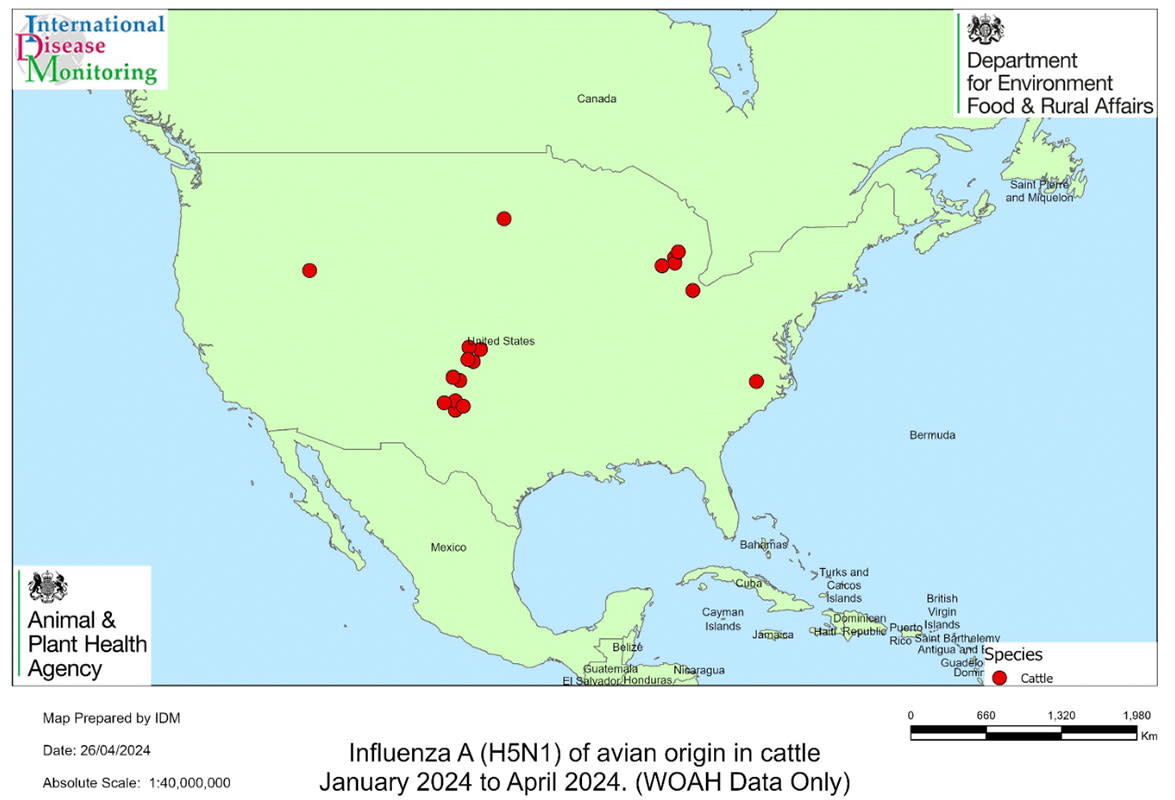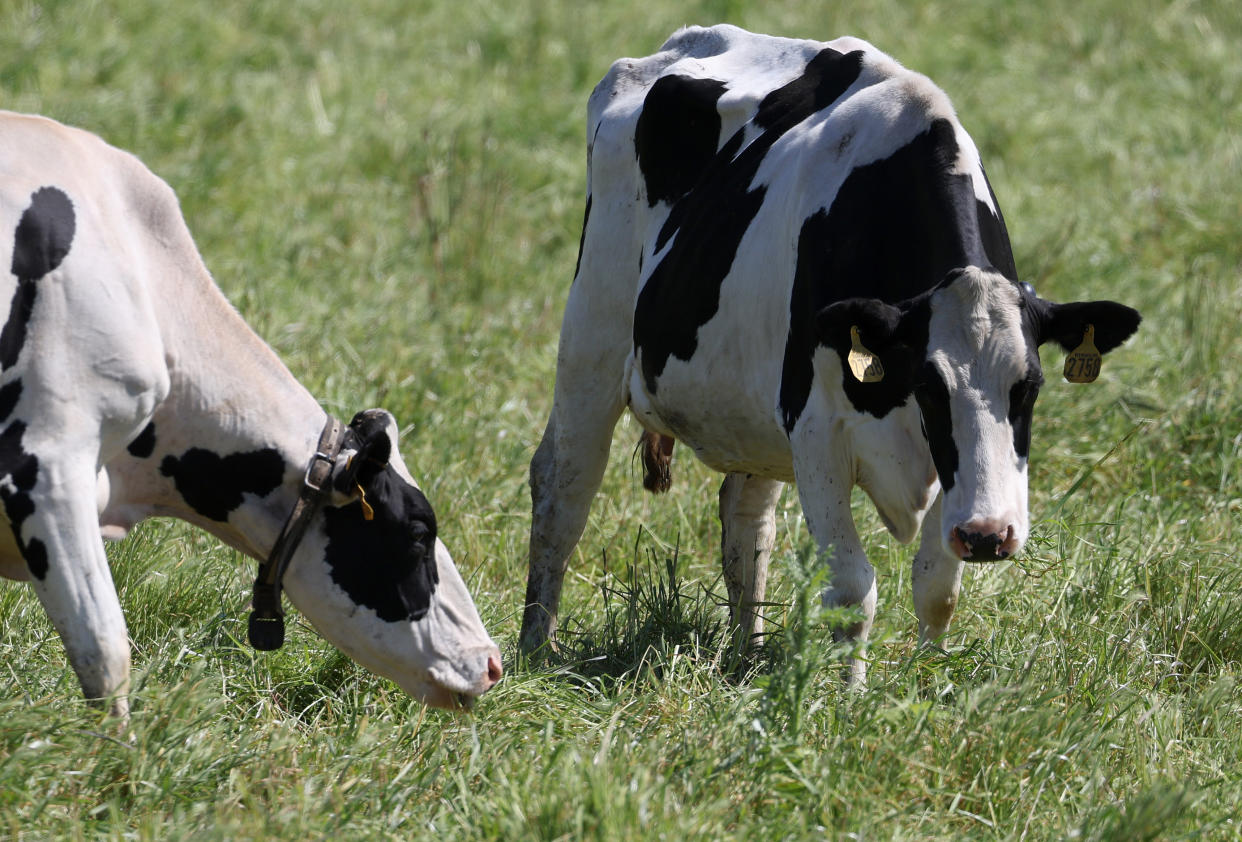British scientists are closely monitoring the bird flu outbreak in the US after the H5N1 virus infected more than 30 herds of cattle across multiple states.
One person has been infected after contact with cows.
At present, UK cows are not being tested for bird flu, with Department for Environment, Food and Rural Affairs (Defra) scientists monitoring the US situation.
The virus is believed to have been spreading in the US for weeks, with tests showing one in five US commercial milk samples contained remnants of the virus, suggesting the outbreak is more widespread than previously thought.
What is happening in the US?
America’s Center for Disease Control (CDC) says there is an outbreak in nine states, affecting 34 dairy herds.
Traces of avian flu virus are widely found in milk on sale in the US but there is no risk to humans from drinking pasteurised milk, authorities said. Their investigation found the pasteurisation process had successfully killed the virus meaning it was not infectious.
US officials have warned against drinking ‘raw’ (unpasteurised) milk.
One person, a Texas farm worker, has been confirmed to have bird flu and suffered conjunctivitis (an eye infection) in the current outbreak following exposure to dairy cows.


The CDC said: “This is the first time that these bird flu viruses were found in cattle. CDC confirmed one human HPAI A(H5N1) infection that had exposure to dairy cattle in Texas that were presumed to be infected with the virus.
“While thought to be rare, this exposure to HPAI A(H5N1) bird flu virus is the first instance of likely mammal to human transmission.”
What does it mean for the UK?
British cows are not currently being tested for bird flu.
DEFRA has said there is no evidence that the virus is currently spreading among cattle in the UK, but is monitoring the US outbreak closely.
It said the virus is different from the H5N1 that has been circulating in the UK and Europe and that the likelihood of an identical virus emerging in cattle in the UK was “highly improbable”.
It warns that the most likely entry of the US H5N1 virus into the UK is via trade in bovine products from affected farms in the US, or by migratory wild birds. However, Defra has said this risk of birds introducing it is “very low” and that there is no trade in live cattle, adding: “There is no evidence that this [introducing of the virus to the UK] has occurred based on genomic analysis of outbreaks in Great Britain.”


The US is approved for the import of raw milk. While it is not thought there is any risk to humans from drinking pasteurised milk, the CDC says that “people with close, prolonged, or unprotected exposures… to unpasteurized (“raw”) milk… are at a greater risk of infection.”
No action has been taken by UK officials to restrict the import of products of animal origin from the US, according to officials.
Scientists at the UK Health Security Agency and Defra have also urged farmers to be “vigilant”.
A situation assessment published by Defra on 25 April said: “All dairy keepers should remain vigilant and ensure that any visitors to their premises have not had any recent contact with dairy cattle or cattle premises in the affected regions.
“People who have been working on farms or with animals returning from any affected areas should avoid any contact with domestic cattle or domestic poultry in commercial holdings and smallholdings.”
Why are people worried?
Experts are concerned that the virus may evolve to be able to spread between humans.
Scientists at the United Nations have described the ongoing H5N1 bird flu infections as a “significant public health concern”, but outlining that no human-to-human H5N1 transmission has yet been recorded.
Dr Jeremy Farrar, Chief Scientist at the World Health Organization (WHO) said the bird flu has an ‘extremely high’ mortality rate in humans. Farrar said that H5N1 has spread from poultry and ducks to animals such as dairy cows.
Both the CDC and the UKHSA say the risk to the public remains low, but Farrar has warned that the virus evolving to be able to spread from human to human is a ‘great concern’.
Farrar said that health authorities have to “make sure that if H5N1 did come across to humans with human-to-human transmission, that we were in a position to immediately respond with access equitably to vaccines, therapeutics and diagnostics.”
Is the virus evolving?
The virus in the human case is significantly different from the bird flu virus samples taken from infected cattle that were made public by government officials last weekend, said Dr. Michael Worobey, an evolutionary biologist from the University of Arizona.
The difference between the genetic sequences of the worker’s virus and the 239 other samples provided indicates that “this was a very longstanding, widespread epidemic.”
A CDC spokesperson said there are “always some subtle changes in genetic sequences when flu viruses move from host-to-host,” but added that the data points to the virus emerging from birds to infect cows and then transmission to the human.

Sarah Carter is a health and wellness expert residing in the UK. With a background in healthcare, she offers evidence-based advice on fitness, nutrition, and mental well-being, promoting healthier living for readers.








